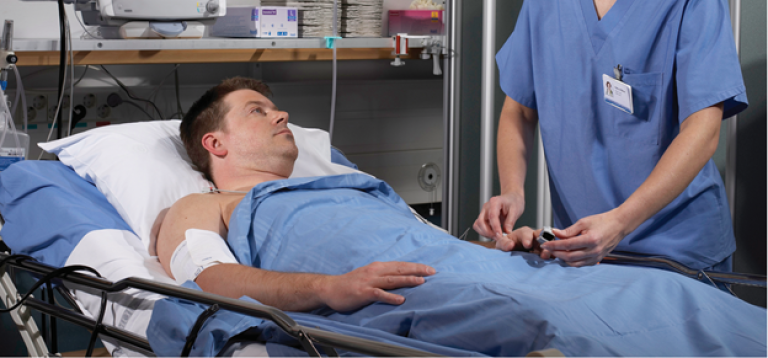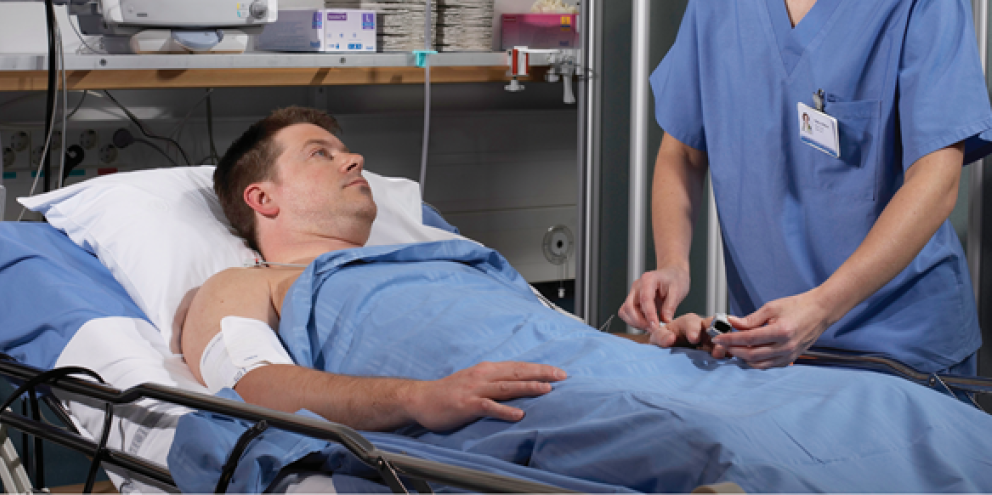
According to the World Health Organization (WHO), hospital-acquired infections (HAIs) are the most frequently occurring adverse event in healthcare.[1] It’s estimated at any given time, more than 1.4 million patients worldwide are suffering from an HAI.[2]
HAIs increase the length of hospital stay (further increasing the risk of additional HAIs), cost the healthcare system billions of dollars, and increase patient mortality.[3]
When it comes to reducing HAIs, keeping the hospital ward and the equipment used free of pathogens is key. This involves cleaning or sanitizing equipment which can be costly as well as time-consuming. One way to help reduce the burden of cleaning reusable items is by using single-use medical equipment.
Today we’re going to review HAIs, their prevalence and impact on healthcare systems as well as communities – and how single-use medical devices aim to help reduce them.
What is a Hospital-acquired Infection?
HAIs are infections in hospital patients that were not there at the time of admission. Another term for HAIs are nosocomial infections.3
When evaluating the prevalence of HAIs, there are certain types of infections most often seen in the hospital, including:3
- Central line-associated bloodstream infections (CLABSI)
- Catheter-associated urinary tract infections (CAUTI)
- Surgical site infections (SSI)
- Hospital-acquired pneumonia (HAP)
- Ventilator-associated pneumonia (VAP)
- Clostridium difficile infections (CDI)
Hospital systems tend to use these common infections to track HAIs as well as monitor interventions to reduce their prevalence on the ward. HAIs not only impact the infected patient but are considered a community problem too since multidrug-resistant pathogens are often involved.3
When it comes to determining what causes HAIs, there are three main sources. One being the patient’s own immune function. A compromised immune system is more at risk for contracting an HAI.3
Other patient-specific risk factors including advanced age, prolonged hospital stay, underlying comorbidities, and having indwelling catheters.3 Urinary and central line catheters and ventilators are often a common factor in patients who develop HAIs.[4]
The other two are environmental factors – including the infectious control practices within the healthcare facility and the prevalence of various pathogens within the community.3
How Prevalent are Hospital Acquired Infections?
Reports vary on the prevalence of HAIs but there’s no denying HAIs are a major health concern globally.
In the U.S., 4% of hospitalized patients will suffer from an HAI.3 That number increases to 6.5% in Europe.1
The WHO reports 7% of hospitalized patients in high-income economies and 10% of patients from developing economies will experience an HAI.2
The percentage of patients who will have an HAI drastically increases when you look inside the ICU. Nearly one in five ICU patients will have at least one HAI during hospital admission according to a study of over 230,000 patients across 947 hospitals.3
Urinary tract infections and bloodstream infections (sepsis) are the two most common HAIs followed by respiratory tract infections including pneumonia according to a 2021 study in the United Kingdom.1
E. coli and S. aureus are the most prevalent source organisms of HAIs.1
The COVID-19 pandemic brought an increase in patient acuity and length-of-stay in the hospital – two risk factors for developing an HAI. One report states there was an increase in nearly all of the top HAIs in 2020 compared to 2019 at the height of the pandemic.[5]
Consequences of Hospital-acquired Infections
HAIs increase the risk of complications including increasing the odds of death in hospitalized patients.3 One out of every 10 patients who have at least one HAI will die.2
They also increase the development of multi-drug resistant organisms which are more difficult to treat and can lead to serious illness.4
Not only do HAIs increase patient deaths and deadly organism development, but they also increase costs to both hospital systems and the community. In the U.S. alone it is estimated HAIs have direct medical costs of over $28 billion every year. Indirect costs related to early death and lost productivity is estimated at $12.4 billion.[6]
Many of the additional costs are due to the increased length of stay caused by HAIs. One study reports the length of stay doubles when a patient has an HAI. If a patient had a multi-drug resistant infection the average additional time spent in the hospital was 14 days.[7]
Ways to Reduce Hospital Acquired Infections
When it comes to reducing HAIs there are many aspects to consider. Hand hygiene, environmental hygiene, following patient safety guidelines, and antibiotic stewardship are all ways to reduce HAIs.2
Environmental hygiene is essential to preventing and controlling the spread of infection in the hospital. Surfaces in the hospital ranging from call buttons, mattresses, and medical devices can all carry and grow microbes just like our hands can.2
Unfortunately, environmental hygiene isn’t as straight-forward as hand hygiene. Cleaning must be performed in very methodical ways to reduce the survival of these pathogens.2
If equipment is disinfected or sterilized between patients, it can be safely used multiple times.[8] However, disinfecting equipment between patient use can be time-consuming and cumbersome. There are usually several steps involved in cleaning reusable equipment including cleaning or transport to sterilization, drying, storing, and then documenting the equipment cleaning processes.[9]
If equipment isn’t properly cleaned, microbes have the potential to survive and proliferate on the surface from patient blood, tissue, or other debris left behind.8 These microbes can contribute to the development of HAIs and should be considered an additional source of HAIs according to the Food and Drug Administration.8
Reducing sources of HAIs can be as simple as replacing reusable equipment with single-use equipment whenever possible.
While it may initially seem like single-use equipment would drive healthcare costs up, the opposite has been seen in various studies. When taking into consideration the cleaning or sterilization procedures and time it takes healthcare workers to complete them, single-use items can actually save healthcare dollars.9
A 2019 study of spinal surgical patients found that when single-use devises were used during surgery, there was significant money and time savings. The study also noted the potential for reducing surgical delays if there weren’t any reusable devices available.[10]
In 2020, the Indian Society of Critical Care Medicine submitted a position paper regarding infection prevention and control in the ICU during the COVID-19 pandemic. The first recommendation when it comes to environmental decontamination is to use single-use or disposable equipment as much as possible.[11]
While more research is needed to know if single-use items reduce the incidence of HAIs, they certainly have the potential to support environmental hygiene efforts without increasing workload or healthcare costs.
Summary
- Hospital Acquired Infections (HAIs) are a common cause of death in hospitalized patients and are considered a global concern
- Patient immune function, environmental hygiene, and community pathogens are all factors related to HAI risk
- Medical equipment that has not been properly cleaned or sanitized is considered a risk for HAI development
- Single-use equipment eliminates the need for cleaning which can save time and money and may potentially help reduce the spread of HAIs
References
[1] Steward, S et al. (2021). Epidemiology of healthcare-associated infection reported from a hospital wide incidence study: considerations for infection prevention and control. The Journal of Hospital Infection. 114: 10-22.
[2] Haque, M et al. (2020). Strategies to prevent healthcare-associated infections: a narrative overview. Risk Management Healthcare Policy. 13: 1765-1780.
[3] Monegro, A, Muppidi, V, & Regunath. H. (2022). Hospital acquired infections. NIH StatPearls.
[4] Shalini, S, Vidyasree, M, & Abiselvi, A. (2015). Impact of effect of nosocomial infections: a review. Research Journal of Pharmaceutical, Biological, and Chemical Sciences. 6(1): 947-951.
[5] U.S. Department of Health & Human Services. (2020). 2020 national and state healthcare-associated infections progress report. https://www.cdc.gov/hai/data/portal/progress-report.html
[6] Centers for Disease Control and Prevention. (2021). Healthcare-associated infections. Office of the Associated Director for Policy and Strategy.
[7] Jia, H et al. (2019). Impact of healthcare-associated infections on length of stay: a study in 68 hospitals in China. BioMed Research International. Vol 2019.
[8] Food and Drug Administration. (2022). Reprocessing of reusable medical devices. Products and Medical Procedures. https://www.fda.gov/medical-devices/products-and-medical-procedures/rep…
[9] Voigt, J et al. (2021). Comparison of the costs of reusable versus disposable equipment for endoscopic carpal tunnel release procedures using activity-based costing analysis. The Journal of Hand Surgery. 46(4):339.
[10] Bouthors, C, et al. (2019). Single-use versus reusable medical devices in spinal fusion surgery: a hospital micro-costing analysis. European Journal of Orthopedic Surgery and Traumatology. 29:1631-1637.
[11] Sharma, J et al. (2020). Infection prevention and control for ICU during COVID-19 pandemic: position paper of the Indian society of critical care medicine. Indian Journal of Critical Care Medicine. 24(Suppl 5): S280-S289.







